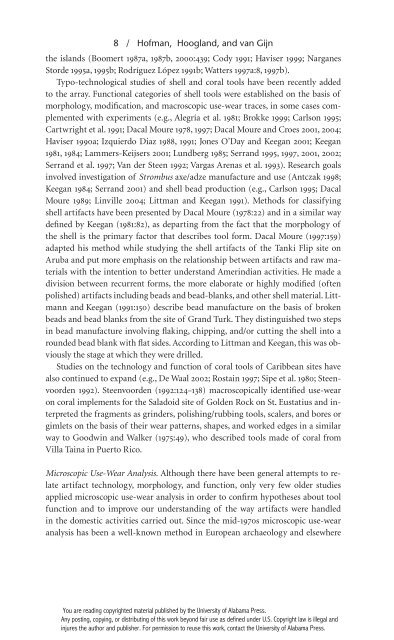Crossing the Borders: New Methods and Techniques in the Study of Archaeological Materials from the Caribbean
by Corrine L. Hoffman, et. al.
by Corrine L. Hoffman, et. al.
You also want an ePaper? Increase the reach of your titles
YUMPU automatically turns print PDFs into web optimized ePapers that Google loves.
8 / H<strong>of</strong>man, Hoogl<strong>and</strong>, <strong>and</strong> van Gijn<br />
<strong>the</strong> isl<strong>and</strong>s (Boomert 1987a, 1987b, 2000:439; Cody 1991; Haviser 1999; Narganes<br />
Storde 1995a, 1995b; Rodríguez López 1991b; Watters 1997a:8, 1997b).<br />
Typo- technological studies <strong>of</strong> shell <strong>and</strong> coral tools have been recently added<br />
to <strong>the</strong> array. Functional categories <strong>of</strong> shell tools were established on <strong>the</strong> basis <strong>of</strong><br />
morphology, modification, <strong>and</strong> macroscopic use- wear traces, <strong>in</strong> some cases complemented<br />
with experiments (e.g., Alegría et al. 1981; Brokke 1999; Carlson 1995;<br />
Cartwright et al. 1991; Dacal Moure 1978, 1997; Dacal Moure <strong>and</strong> Croes 2001, 2004;<br />
Haviser 1990a; Izquierdo Diaz 1988, 1991; Jones O’Day <strong>and</strong> Keegan 2001; Keegan<br />
1981, 1984; Lammers- Keijsers 2001; Lundberg 1985; Serr<strong>and</strong> 1995, 1997, 2001, 2002;<br />
Serr<strong>and</strong> et al. 1997; Van der Steen 1992; Vargas Arenas et al. 1993). Research goals<br />
<strong>in</strong>volved <strong>in</strong>vestigation <strong>of</strong> Strombus axe/ adze manufacture <strong>and</strong> use (Antczak 1998;<br />
Keegan 1984; Serr<strong>and</strong> 2001) <strong>and</strong> shell bead production (e.g., Carlson 1995; Dacal<br />
Moure 1989; L<strong>in</strong>ville 2004; Littman <strong>and</strong> Keegan 1991). <strong>Methods</strong> for classify<strong>in</strong>g<br />
shell artifacts have been presented by Dacal Moure (1978:22) <strong>and</strong> <strong>in</strong> a similar way<br />
def<strong>in</strong>ed by Keegan (1981:82), as depart<strong>in</strong>g <strong>from</strong> <strong>the</strong> fact that <strong>the</strong> morphology <strong>of</strong><br />
<strong>the</strong> shell is <strong>the</strong> primary factor that describes tool form. Dacal Moure (1997:159)<br />
adapted his method while study<strong>in</strong>g <strong>the</strong> shell artifacts <strong>of</strong> <strong>the</strong> Tanki Flip site on<br />
Aruba <strong>and</strong> put more emphasis on <strong>the</strong> relationship between artifacts <strong>and</strong> raw materials<br />
with <strong>the</strong> <strong>in</strong>tention to better underst<strong>and</strong> Amer<strong>in</strong>dian activities. He made a<br />
division between recurrent forms, <strong>the</strong> more elaborate or highly modified (<strong>of</strong>ten<br />
polished) artifacts <strong>in</strong>clud<strong>in</strong>g beads <strong>and</strong> bead- blanks, <strong>and</strong> o<strong>the</strong>r shell material. Littmann<br />
<strong>and</strong> Keegan (1991:150) describe bead manufacture on <strong>the</strong> basis <strong>of</strong> broken<br />
beads <strong>and</strong> bead blanks <strong>from</strong> <strong>the</strong> site <strong>of</strong> Gr<strong>and</strong> Turk. They dist<strong>in</strong>guished two steps<br />
<strong>in</strong> bead manufacture <strong>in</strong>volv<strong>in</strong>g flak<strong>in</strong>g, chipp<strong>in</strong>g, <strong>and</strong>/ or cutt<strong>in</strong>g <strong>the</strong> shell <strong>in</strong>to a<br />
rounded bead blank with flat sides. Accord<strong>in</strong>g to Littman <strong>and</strong> Keegan, this was obviously<br />
<strong>the</strong> stage at which <strong>the</strong>y were drilled.<br />
Studies on <strong>the</strong> technology <strong>and</strong> function <strong>of</strong> coral tools <strong>of</strong> <strong>Caribbean</strong> sites have<br />
also cont<strong>in</strong>ued to exp<strong>and</strong> (e.g., De Waal 2002; Rosta<strong>in</strong> 1997; Sipe et al. 1980; Steenvoorden<br />
1992). Steenvoorden (1992:124–138) macroscopically identified use- wear<br />
on coral implements for <strong>the</strong> Saladoid site <strong>of</strong> Golden Rock on St. Eustatius <strong>and</strong> <strong>in</strong>terpreted<br />
<strong>the</strong> fragments as gr<strong>in</strong>ders, polish<strong>in</strong>g/ rubb<strong>in</strong>g tools, scalers, <strong>and</strong> bores or<br />
gimlets on <strong>the</strong> basis <strong>of</strong> <strong>the</strong>ir wear patterns, shapes, <strong>and</strong> worked edges <strong>in</strong> a similar<br />
way to Goodw<strong>in</strong> <strong>and</strong> Walker (1975:49), who described tools made <strong>of</strong> coral <strong>from</strong><br />
Villa Ta<strong>in</strong>a <strong>in</strong> Puerto Rico.<br />
Microscopic Use- Wear Analysis. Although <strong>the</strong>re have been general attempts to relate<br />
artifact technology, morphology, <strong>and</strong> function, only very few older studies<br />
applied microscopic use- wear analysis <strong>in</strong> order to confirm hypo<strong>the</strong>ses about tool<br />
function <strong>and</strong> to improve our underst<strong>and</strong><strong>in</strong>g <strong>of</strong> <strong>the</strong> way artifacts were h<strong>and</strong>led<br />
<strong>in</strong> <strong>the</strong> domestic activities carried out. S<strong>in</strong>ce <strong>the</strong> mid-1970s microscopic use- wear<br />
analysis has been a well- known method <strong>in</strong> European archaeology <strong>and</strong> elsewhere<br />
You are read<strong>in</strong>g copyrighted material published by <strong>the</strong> University <strong>of</strong> Alabama Press.<br />
Any post<strong>in</strong>g, copy<strong>in</strong>g, or distribut<strong>in</strong>g <strong>of</strong> this work beyond fair use as def<strong>in</strong>ed under U.S. Copyright law is illegal <strong>and</strong><br />
<strong>in</strong>jures <strong>the</strong> author <strong>and</strong> publisher. For permission to reuse this work, contact <strong>the</strong> University <strong>of</strong> Alabama Press.


















